Jack-o'-lantern
From Wikipedia, the free encyclopedia
For other uses, see Jack-o'-lantern (disambiguation).

A jack-o'-lantern in the shape of the Wikipedia logo.
Contents
[hide]Etymology[edit]
The term jack-o'-lantern is in origin a term for the visual phenomenon ignis fatuus (lit., "foolish fire") known as a will-o'-the-wisp in English folklore. Used especially in East Anglia, its earliest known use dates to the 1660s.[1] The term "will-o'-the-wisp" uses "wisp" (a bundle of sticks or paper sometimes used as a torch) and the proper name "Will": thus, "Will-of-the-torch." The term jack-o'-lantern is of the same construction: "Jack of [the] lantern." See Origin: Folklore below.Origin[edit]
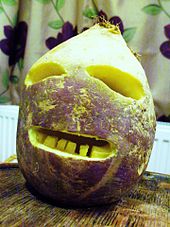
Modern carving of a Cornish Jack-o'-Lantern made from a turnip.
There is however evidence that turnips were used to carve what was called a "Hoberdy's Lantern" in Worcestershire, England at the end of the 18th century. The folklorist Jabez Allies recalls how
| “ | In my juvenile days I remember to have seen peasant boys make, what they called a " Hoberdy's Lantern," by hollowing out a turnip, and cutting eyes, nose, and mouth therein, in the true moon-like style ; and having lighted it up by inserting the stump of a candle, they used to place it upon a hedge to frighten unwary travellers in the night.[15] | ” |
In literature and popular culture[edit]
The application of the term to carved pumpkins in American English is first attested in 1834.[16] The carved pumpkin lantern association with Halloween is recorded in 1866 in the U.S.[17] In the United States, the carved pumpkin was first associated with the harvest season in general, long before it became an emblem of Halloween.[18] In 1900, an article on Thanksgiving entertaining recommended a lit jack-o'-lantern as part of the festivities.[18] The poet John Greenleaf Whittier, who was born in Massachusetts in 1807, wrote "The Pumpkin" (1850):[19]| “ | Oh!—fruit loved of boyhood!—the old days recalling, When wood-grapes were purpling and brown nuts were falling! When wild, ugly faces we carved in its skin, Glaring out through the dark with a candle within! | ” |
- Jack o' the lantern! Joan the wad,
- Who tickled the maid and made her mad
- Light me home, the weather's bad.
Folklore[edit]
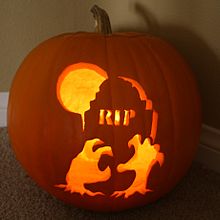
A commercial "R.I.P." pattern

Halloween jack-o'-lantern
Another version[citation needed] of the story says that Jack was getting chased by some villagers from whom he had stolen, when he met the Devil, who claimed it was time for him to die. However, the thief stalled his death by tempting the Devil with a chance to bedevil the church-going villagers chasing him. Jack told the Devil to turn into a coin with which he would pay for the stolen goods (the Devil could take on any shape he wanted); later, when the coin/Devil disappeared, the Christian villagers would fight over who had stolen it. The Devil agreed to this plan. He turned himself into a silver coin and jumped into Jack's wallet, only to find himself next to a cross Jack had also picked up in the village. Jack had closed the wallet tight, and the cross stripped the Devil of his powers; and so he was trapped.
In both folktales, Jack only lets the Devil go when he agrees never to take his soul. After a while the thief died, as all living things do. Of course, his life had been too sinful for Jack to go to heaven; however, the Devil had promised not to take his soul, and so he was barred from hell as well. Jack now had nowhere to go. He asked how he would see where to go, as he had no light, and the Devil mockingly tossed him an ember from the flames of hell, that would never burn out. Jack carved out one of his turnips (which were his favorite food), put the ember inside it, and began endlessly wandering the Earth for a resting place. He became known as "Jack of the Lantern", or Jack-o'-lantern.
Jack-o-lanterns were also a way of protecting your home against the Undead. Superstitious people used them specifically to ward away vampires. They thought this because it was said that the Jack-o-lantern's light was a way of identifying vampires and, once their identity was known, they would give up their hunt for you.[citation needed]
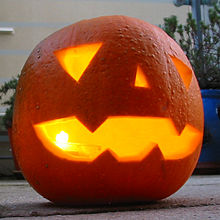
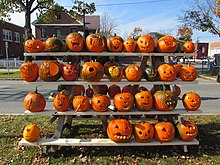

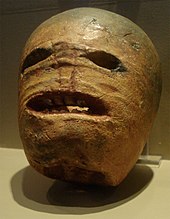
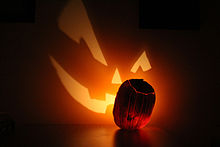

No comments:
Post a Comment